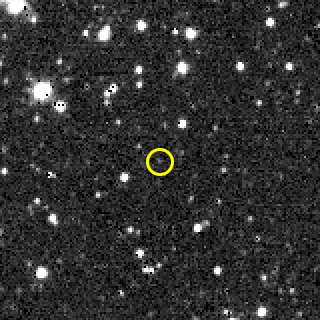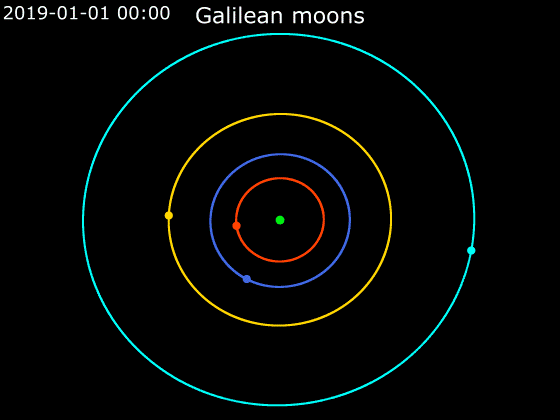|
Pasiphae (moon)
Pasiphae , formerly spelled Pasiphaë, is a retrograde irregular satellite of Jupiter. It was discovered in 1908 by Philibert Jacques Melotte and later named after the mythological Pasiphaë, wife of Minos and mother of the Minotaur from Greek legend. The moon was first spotted on a plate taken at the Royal Greenwich Observatory on the night of 28 February 1908. Inspection of previous plates found it as far back as January 27. It received the provisional designation , as it was not clear whether it was an asteroid or a moon of Jupiter. The recognition of the latter case came by April 10. Pasiphae did not receive its present name until 1975; before then, it was simply known as . It was sometimes called "Poseidon" between 1955 and 1975. Orbit Pasiphae orbits Jupiter on a high eccentricity and high inclination retrograde orbit. It gives its name to the Pasiphae group, irregular retrograde moons orbiting Jupiter at distances ranging between 22.8 and 24.1 million km, and with ... [...More Info...] [...Related Items...] OR: [Wikipedia] [Google] [Baidu] |
Pasithee (moon)
Pasithee , also known as , is a retrograde irregular satellite of Jupiter. It was discovered by a team of astronomers from the University of Hawaii led by Scott S. Sheppard in 2001, and given the temporary designation .MPEC 2002-J54: ''Eleven New Satellites of Jupiter'' May 15, 2002 (discovery and ephemeris) Pasithee is about 2 kilometres in diameter, and orbits Jupiter at an average distance of 23,307,000 km in 711.12 days, at an of 166° to the (164° to Jupiter's equator), in a [...More Info...] [...Related Items...] OR: [Wikipedia] [Google] [Baidu] |
Royal Greenwich Observatory
The Royal Observatory, Greenwich (ROG; known as the Old Royal Observatory from 1957 to 1998, when the working Royal Greenwich Observatory, RGO, temporarily moved south from Greenwich to Herstmonceux) is an observatory situated on a hill in Greenwich Park in south east London, overlooking the River Thames to the north. It played a major role in the history of astronomy and navigation, and because the Prime Meridian passes through it, it gave its name to Greenwich Mean Time, the precursor to today's Coordinated Universal Time (UTC). The ROG has the IAU observatory code of 000, the first in the list. ROG, the National Maritime Museum, the Queen's House and the clipper ship ''Cutty Sark'' are collectively designated Royal Museums Greenwich. The observatory was commissioned in 1675 by King Charles II, with the foundation stone being laid on 10 August. The old hilltop site of Greenwich Castle was chosen by Sir Christopher Wren, a former Savilian Professor of Astronomy; as Greenwi ... [...More Info...] [...Related Items...] OR: [Wikipedia] [Google] [Baidu] |
Infrared
Infrared (IR), sometimes called infrared light, is electromagnetic radiation (EMR) with wavelengths longer than those of visible light. It is therefore invisible to the human eye. IR is generally understood to encompass wavelengths from around 1 millimeter (300 GHz) to the nominal red edge of the visible spectrum, around 700 nanometers (430 THz). Longer IR wavelengths (30 μm-100 μm) are sometimes included as part of the terahertz radiation range. Almost all black-body radiation from objects near room temperature is at infrared wavelengths. As a form of electromagnetic radiation, IR propagates energy and momentum, exerts radiation pressure, and has properties corresponding to both those of a wave and of a particle, the photon. It was long known that fires emit invisible heat; in 1681 the pioneering experimenter Edme Mariotte showed that glass, though transparent to sunlight, obstructed radiant heat. In 1800 the astronomer Sir William Herschel discovered ... [...More Info...] [...Related Items...] OR: [Wikipedia] [Google] [Baidu] |
Elara (moon)
Elara is a prograde irregular satellite of Jupiter. It was discovered by Charles Dillon Perrine at Lick Observatory in 1905 in photographs taken with the 36" Crossley reflecting telescope which he had recently rebuilt. It is the eighth-largest moon of Jupiter and is named after Elara, one of Zeus's lovers and the mother of the giant Tityos. Elara did not receive its present name until 1975; before then, it was simply known as . It was sometimes called "Hera" between 1955 and 1975. It has a mean radius of just , thus it is 2% of the size of Europa. However, it is half the size of Himalia, so it is the second-biggest moon in the Himalia group. It might be a captured type C or D asteroid, for it reflects very little light. Elara belongs to the Himalia group, moons orbiting between 11 and 13 gigametres from Jupiter at an inclination of about 27.5°. Its orbital elements are as of January 2000. They are continuously changing due to solar and planetary perturbations. Disc ... [...More Info...] [...Related Items...] OR: [Wikipedia] [Google] [Baidu] |
Himalia (moon)
Himalia (), or Jupiter VI, is the largest irregular satellite of Jupiter, with a diameter of at least . It is the sixth largest Jovian satellite, after the four Galilean moons and Amalthea. It was discovered by Charles Dillon Perrine at the Lick Observatory on 3 December 1904 and is named after the nymph Himalia, who bore three sons of Zeus (the Greek equivalent of Jupiter). It is one of the largest planetary moons in the Solar System not imaged in detail, and the third largest not imaged in detail within the orbit of Neptune. Discovery Himalia was discovered by Charles Dillon Perrine at the Lick Observatory on 3 December 1904 in photographs taken with the 36-inch Crossley reflecting telescope which he had recently rebuilt. ; ; ; Himalia is Jupiter's most easily observed small satellite; though Amalthea is brighter, its proximity to the planet's brilliant disk makes it a far more difficult object to view. Name Himalia is named after the nymph Himalia, who bore thr ... [...More Info...] [...Related Items...] OR: [Wikipedia] [Google] [Baidu] |
Secular Resonance
A secular resonance is a type of orbital resonance between two bodies with synchronized precessional frequencies. In celestial mechanics, secular refers to the long-term motion of a system, and resonance is periods or frequencies being a simple numerical ratio of small integers. Typically, the synchronized precessions in secular resonances are between the rates of change of the argument of the periapses or the rates of change of the longitude of the ascending nodes of two system bodies. Secular resonances can be used to study the long-term orbital evolution of asteroids and their families within the asteroid belt. Description Secular resonances occur when the precession of two orbits is synchronised (a precession of the perihelion, with frequency g, or the ascending node, with frequency s, or both). A small body (such as a small Solar System body) in secular resonance with a much larger one (such as a planet) will precess at the same rate as the large body. Over relatively shor ... [...More Info...] [...Related Items...] OR: [Wikipedia] [Google] [Baidu] |
Callisto (moon)
Callisto (), or Jupiter IV, is the second-largest moon of Jupiter, after Ganymede. It is the third-largest moon in the Solar System after Ganymede and Saturn's largest moon Titan, and the largest object in the Solar System that may not be properly differentiated. Callisto was discovered in 1610 by Galileo Galilei. With a diameter of , Callisto is about 99% the diameter of the planet Mercury, but only about a third of its mass. It is the fourth Galilean moon of Jupiter by distance, with an orbital radius of about . It is not in an orbital resonance like the three other Galilean satellites— Io, Europa, and Ganymede—and is thus not appreciably tidally heated. Callisto's rotation is tidally locked to its orbit around Jupiter, so that the same hemisphere always faces inward. Because of this, there is a sub-Jovian point on Callisto's surface, from which Jupiter would appear to hang directly overhead. It is less affected by Jupiter's magnetosphere than the other inner satell ... [...More Info...] [...Related Items...] OR: [Wikipedia] [Google] [Baidu] |
Apsis
An apsis (; ) is the farthest or nearest point in the orbit of a planetary body about its primary body. For example, the apsides of the Earth are called the aphelion and perihelion. General description There are two apsides in any elliptic orbit. The name for each apsis is created from the prefixes ''ap-'', ''apo-'' (), or ''peri-'' (), each referring to the farthest and closest point to the primary body the affixing necessary suffix that describes the primary body in the orbit. In this case, the suffix for Earth is ''-gee'', so the apsides' names are ''apogee'' and ''perigee''. For the Sun, its suffix is ''-helion'', so the names are ''aphelion'' and ''perihelion''. According to Newton's laws of motion, all periodic orbits are ellipses. The barycenter of the two bodies may lie well within the bigger body—e.g., the Earth–Moon barycenter is about 75% of the way from Earth's center to its surface. If, compared to the larger mass, the smaller mass is negligible (e.g., f ... [...More Info...] [...Related Items...] OR: [Wikipedia] [Google] [Baidu] |
Carolyn C
Carolyn is a female given name, a variant of Caroline. Other spellings include Karolyn, Carolyne, Carolynn or Carolynne. Caroline itself is one of the feminine forms of Charles. List of Notable People *Carolyn Bennett (born 1950), Canadian politician *Carolyn Bertozzi (born 1966), American chemist and Nobel laureate *Carolyn Bessette-Kennedy (1966–1999), wife of John F. Kennedy, Jr. *Carolyn Brown (choreographer) (born 1927), American dancer, choreographer, and writer *Carolyn Brown (newsreader), English newsreader *Carolyn Cassady (1923–2013), American writer and wife of Neal Cassady *C. J. Cherryh (Carolyn Janice Cherryh; born 1942), American science fiction and fantasy writer *Carolyn Chiechi (born 1943), judge of the United States Tax Court *Carolyn Cooper (born 1959), Jamaican author and literary scholar * Carolyn Davidson, several people * Carolyn Eaton, murder victim * Carolyn Fe, Filipina singer and actress *Carolyn Forché (born 1950), American poet, editor, transla ... [...More Info...] [...Related Items...] OR: [Wikipedia] [Google] [Baidu] |
David C
David (; , "beloved one") (traditional spelling), , ''Dāwūd''; grc-koi, Δαυΐδ, Dauíd; la, Davidus, David; gez , ዳዊት, ''Dawit''; xcl, Դաւիթ, ''Dawitʿ''; cu, Давíдъ, ''Davidŭ''; possibly meaning "beloved one". was, according to the Hebrew Bible, the third king of the United Kingdom of Israel. In the Books of Samuel, he is described as a young shepherd and Lyre, harpist who gains fame by slaying Goliath, a champion of the Philistines, in southern Canaan. David becomes a favourite of Saul, the first king of Israel; he also forges David and Jonathan, a notably close friendship with Jonathan (1 Samuel), Jonathan, a son of Saul. However, under the paranoia that David is seeking to usurp the throne, Saul attempts to kill David, forcing the latter to go into hiding and effectively operate as a fugitive for several years. After Saul and Jonathan are both killed in battle against the Philistines, a 30-year-old David is anointed king over all of History of ... [...More Info...] [...Related Items...] OR: [Wikipedia] [Google] [Baidu] |
Scott S
Scott may refer to: Places Canada * Scott, Quebec, municipality in the Nouvelle-Beauce regional municipality in Quebec * Scott, Saskatchewan, a town in the Rural Municipality of Tramping Lake No. 380 * Rural Municipality of Scott No. 98, Saskatchewan United States * Scott, Arkansas * Scott, Georgia * Scott, Indiana * Scott, Louisiana * Scott, Missouri Scott is an unincorporated community in Cole County, in the U.S. state of Missouri. The community is located on Grays Creek just northwest of Jefferson City Jefferson City, informally Jeff City, is the capital of Missouri, United States. It ... * Scott, New York * Scott, Ohio * Scott, Wisconsin (other) (several places) * Fort Scott, Kansas * Great Scott Township, St. Louis County, Minnesota * Scott Air Force Base, Illinois * Scott City, Kansas * Scott City, Missouri * Scott County (other) (various states) * Scott Mountain, a mountain in Oregon * Scott River, in California * Scott Township (disambiguat ... [...More Info...] [...Related Items...] OR: [Wikipedia] [Google] [Baidu] |





.png)
